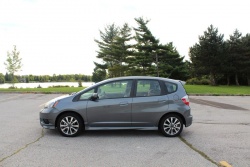 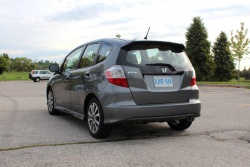 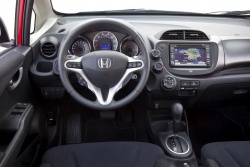 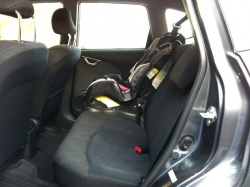 2012 Honda Fit. Click image to enlarge |
Review by Justin Pritchard
Vehicle Type: Compact five-door
History/Description: The spiritual successor to the Civic Hatchback, Honda’s Fit launched in Canada for 2007 with a cleverly-designed body and cabin that translated into a whole whack of space in a small package. Big on flexibility, efficiency and reliability, Fit found homes in the driveways of thousands of active Canadians, students, busy couples, pet lovers and outdoors buffs alike.
Crammed with 2,572 litres of interior volume and 1,622 litres of cargo space, Fit owners benefit from rear seats that flip up or down to accommodate a variety of items. Tall plants, bikes and even furniture can be fit inside – making the Fit an ideal alternative to a larger, thirstier crossover SUV to many shoppers.
Music lovers will notice the availability of a 200-watt stereo system that comes with six speakers, tweeters and a five-mode equalizer. The stereo is MP3 compatible, and offers an input jack as well as a USB input.
All Honda Fit trim levels, namely the DX, LX and Sport, feature standard power windows, tilt and telescopic steering, up to eight beverage holders and a fuel consumption display. Air conditioning is available on every model where it isn’t standard. Safety is covered by an advanced antilock braking system, active headrests and side curtain airbags on all models.
Honda’s Advanced Compatibility Engineering (ACE) body structure technology is at work as well, helping with a top-of-class list of standard safety features. ACE is designed to offer the best possible crash impact performance by sending crash energy around the body structure.
Engines / Trim: All models were motivated by a 1.5L i-VTEC four-cylinder engine, offering up to 117 horsepower. The engine drives the front wheels through either a five-speed manual transmission or a five-speed automatic. Paddle shift functionality was available on the Sport model, as was a stability control system in years before it became standard.
DX, LX and Sport trim grades ascend from basic to loaded, with the Fit Sport offering up-level cosmetics like fog-lamps, extra body cladding and alloy wheels. Note that for 2009, a facelift advanced the Fit’s looks and cabin considerably, and bumped horsepower from from 109 to 117. You’ll find an all-around more upscale package in a 2009 or newer model as a result, if your budget allows it. The 2009 update also saw changes that helped the Fit earn a “Top Safety Pick” rating from the IIHS.
What Owners Like: Fit owners tend to rave about mileage, versatility, handling, braking, maneuverability, visibility, ergonomics, and a surprising level of on-board roominess, despite the machine’s compact size. In all, Fit is reported to be an easy car to drive, park and live with on a day to day basis.
At-hand storage in the cabin, especially in the form of cupholders, is praised too – and especially on face-lifted models. The manual transmission is easy to operate here – with a very quick and light throw and a light, forgiving, easygoing clutch. Note that the 09 and newer Fit won a ‘Best New Design’ award from the Automobile Journalists Association of Canada (AJAC) for its commendable combination of looks and functionality.
What Owners Dislike: Fit owners typically complain about a noisy engine and ride, abrupt ride characteristics in some situations, and diminished performance when the vehicle is loaded up. Seats in the pre-facelift models are commonly accused of being uncomfortable – a fact which your writer can back up. As the owner of a 2008 Fit LX, it’s the only car I’ve ever driven that requires a pillow to compensate for the complete lack of lumbar support. Fit could, additionally, use a sixth gear on the highway.
Honda Fit Owner Reviews from Trader.ca
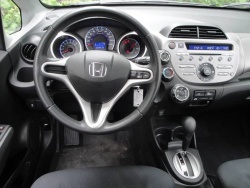 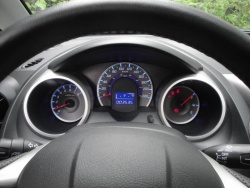 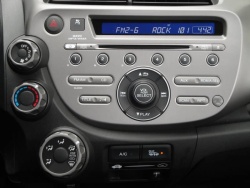 Honda Fit, 2007–2013. Click image to enlarge |
Common Issues: On a test-drive, be sure to inspect your potential used Fit candidate for signs of damaged or peeling paint. The latter may be most prevalent on the front and rear bumpers. Many owners taking to the web to share ownership experiences say they wish for a more durable finish from their Fit.
Check for signs of rust, or repaired rust, around the rear wheel wells where the steel body panel meets the bumper – especially in first generation models. Other areas to check for corrosion include the lower, inner edges of the trunk and doors, the edge of the hood, and around the hatch-latch. Confirm that the rear bumper is properly attached to the body too, as a few small clips hold it on, but they’re somewhat easily broken.
Some reading on finish durability here and here.
Spend a moment inspecting the tailgate. Be sure it stays open on its own, even when you apply slight downwards pressure at the edge when it’s open. You’re confirming that the struts that lift and support the tailgate aren’t worn out. If they are, it could wind up whacking you in the melon unexpectedly. While you’re looking at the tailgate, be sure the first-generation Fit has a properly-functioning external release latch. If it sticks or fails to open the hatch, an occasional blast of WD-40 can help until you wind up replacing the assembly.
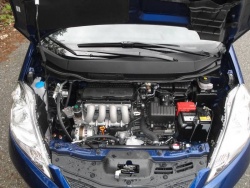 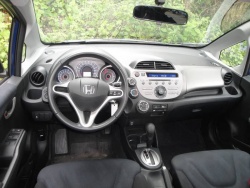 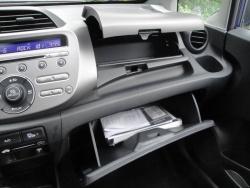 Honda Fit, 2007–2013. Click image to enlarge |
Inside, inspect the seats and carpeting for signs of accelerated wear, which some owners note as an issue. If the fabric or carpet material is worn through, ripped or faded, call it into pricing negotiations.
Mechanically, the Fit looks solid and reliable – though a model that’s been well-maintained is the best bet for long-term performance. Check service records where available, ensuring the model you’re considering was subject to regular fluid changes and tune-ups as prescribed by its owner’s manual. If the service history isn’t clear, a full fluid change (coolant, transmission, oil change, brake fluid) should run you about $150 at a reasonably priced shop. Note that Fit uses a timing chain in its engine, not a belt that requires pricey, periodic replacement. A timing chain should last the life of the engine if you’re fond of regular oil changes.
Bear a few issues in mind on your test-drive.
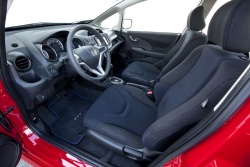 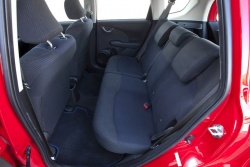 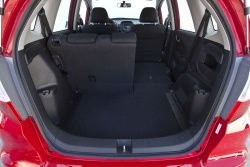 Honda Fit, 2007–2013. Click image to enlarge |
First, note that lumpy, lazy or sporadic power delivery at moderate or full throttle may be the result of failure of one of the four coil packs, which fire the spark plugs. This issue could cause a code to be stored in the engine’s computer, or a check-engine light to illuminate – so be sure to have the computer scanned if you note an issue. Some reading here.
Another issue to be on the watch for is failure of the engine’s VTEC valve-timing system. Note that at full throttle, the Fit should pull strongly, eagerly and smoothly to near redline. If the revs seem to struggle to climb past about 4,000 at full throttle, the VTEC system is likely not engaging, which is probably the result of a failed or failing VTEC solenoid. This electronically-controlled, oil-pressure driven valve physically engages the system at the direction of the engine computer. Performance will suffer drastically if it’s not doing its job.
Replacing the solenoid isn’t a terribly difficult or expensive job. As a side note, I had this issue on my Fit, but it fixed itself before I could get to the dealer for a new solenoid. A check engine light could illuminate if the solenoid acts up, though in my case it didn’t.
Be sure the power steering system feels right, noting any difficulty steering or a lumpy feel to the steering as the wheel is moved, especially when the vehicle is not moving. The Fit should steer easily and smoothly at any speed. If it doesn’t, a fussy Electronic Power Steering (EPS) component could be to blame. Many owners simply restart the engine to bring the system back online if it cuts out – which will illuminate a warning light and drastically increase steering effort.
Some reading on the power steering system here.
Note any slippage on a manual-equipped model, which could indicate a badly worn clutch. Grinding or biting back while shifting gears with the manual transmission are other signs of clutch or transmission trouble. Coax slippage from a worn clutch by applying full throttle at very high engine loads, perhaps at 50 km/h in fourth gear.
|
Related Articles: Manufacturer’s Website: |
A final note – be sure to avoid a used Fit with extensive modifications. Common ‘upgrades’ will include intakes, exhaust systems and wheels, which are typically no cause for alarm. Used models with modified engine management, non-factory engine swaps, forced induction or heavy suspension modifications should be avoided by the average shopper.
The Verdict: Used car shoppers can expect the Fit to command a premium in the used market, in exchange for above-average reliability, versatility and driving pleasure. Seek a mechanical thumbs-up from a Honda mechanic ahead of your purchase, and then buy confidently.
A list of Honda Fit recalls
Crash Test Results:
Insurance Institute for Highway Safety (IIHS): Top Safety Pick (2009 and up)
National Highway Traffic Safety Administration (NHTSA): 4/5 stars (2012)
Assorted reading on the Honda Fit











